This article originally appeared in the September 2021 issue of Growing for Market Magazine.
Part 1: From ordering corms to fall planting
This is part one of a two-part series on growing anemones and ranunculus. Part one covers ordering corms in the spring through planting in the fall. Part two will discuss nurturing your plants through the winter, harvest and post-harvest handling of flowers, and how to save corms.
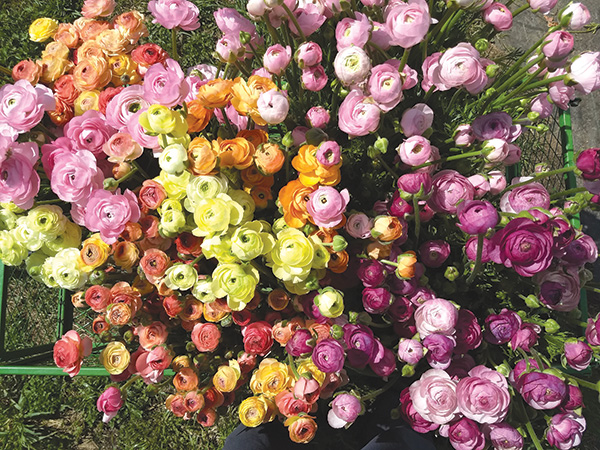 Ranunculus can be harvested at a range of stages. We prefer to cut ours first thing in the morning and mostly closed, with soft buds or loose petals.
Ranunculus can be harvested at a range of stages. We prefer to cut ours first thing in the morning and mostly closed, with soft buds or loose petals.
Ranunculus (Ranunculus asiaticus) and anemones (Anemone coronaria) are two of the most important crops on our farm. Anemones, which we can harvest in our unheated tunnel as early as Valentine’s Day, are our most profitable crop per square foot. Ranunculus starts blooming for us in March and is one of our top sellers by volume.
These two crops are the backbone of our early flower season: They galvanize customer demand and provide critical cash flow in March and April. On top of that, they are relatively easy to grow, so long as you can provide a favorable microclimate and be proactive about managing pests and disease. These articles will walk you through a year of growing these crops and teach you the basic steps to growing them successfully.
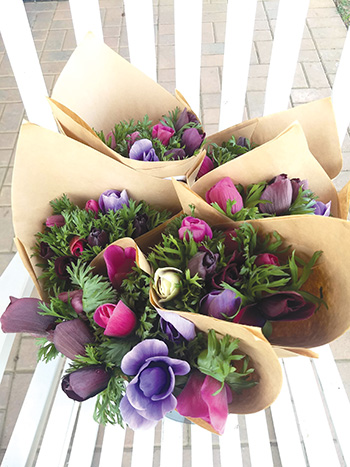 You can harvest anemones when the petals are fully colored, full, and loose. All images courtesy of the author except where noted otherwise.
You can harvest anemones when the petals are fully colored, full, and loose. All images courtesy of the author except where noted otherwise.
We live in the Piedmont of North Carolina, zone 7A. Our average first frost is in late October and our last frost in late April. Although our coldest winter temperatures have reached 0°F multiple times (with temps inside our hoop house getting down to 5°F), our average winter lows are around 32°F with highs around 50°F. By April our lows average around 45°F and our highs around 70°F, and by May these values are around 55°F and 80°F. This gives you context on the temperatures we experience during our anemone and ranunculus growing season so that you can adapt the information to your own farm and climate.
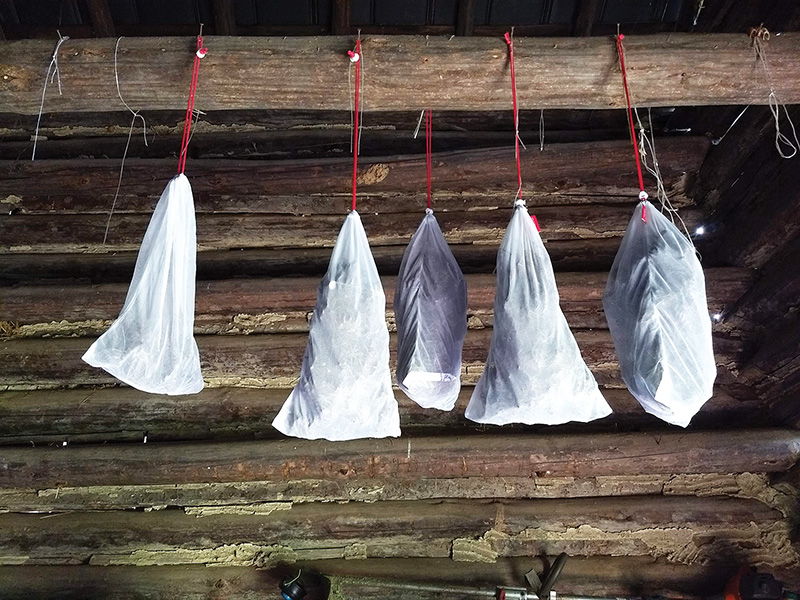 We store Ranunculus corms in mesh bags in our barn.
We store Ranunculus corms in mesh bags in our barn.
Ranunculus and anemones are native to the Mediterranean and understanding their natural environment will help make sense of some of their cultural needs. They grow in an area where it only rains in winter. Summers are bone dry. As a result, they have evolved to become dormant and desiccated in the summer, then to rehydrate and grow once it starts raining in the fall. They become established and grow slowly throughout the cool winter before blooming in spring. Once it gets hot, the plants go dormant in preparation for the dry summer. The more you are able to mimic the climate of their Mediterranean home, the more successful you will be growing these crops.
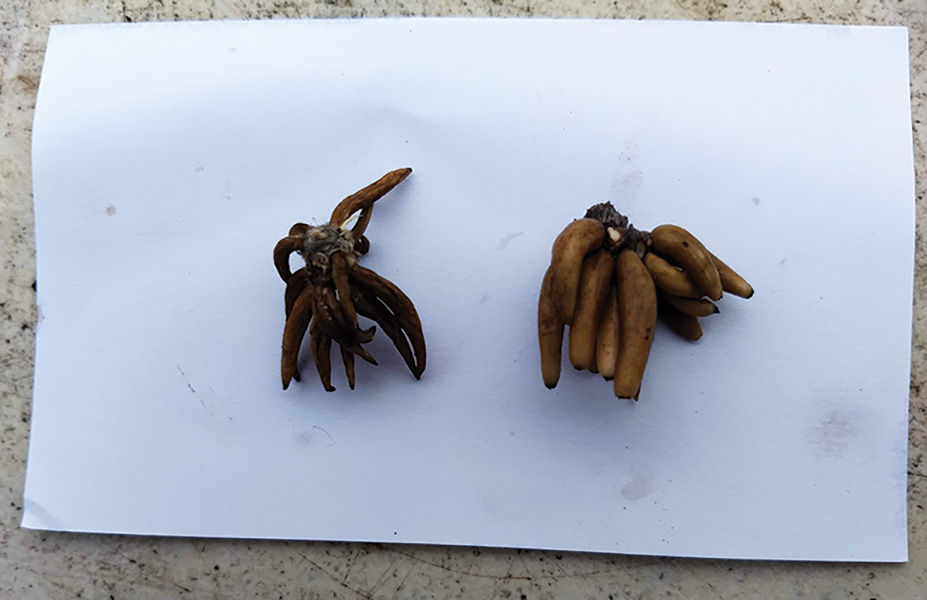 Ranunculus corms, before and after soaking.
Ranunculus corms, before and after soaking.
To accomplish this, season extension is key. Anemones and ranunculus need at least three months of cool to cold temperatures to get established, and then as long a cool period for blooming as possible — at least two more months would be ideal. Although growers in California and a few other places may have mild enough winters and long enough springs to grow them outdoors, in most of the United States, these crops will need to be grown under plastic.
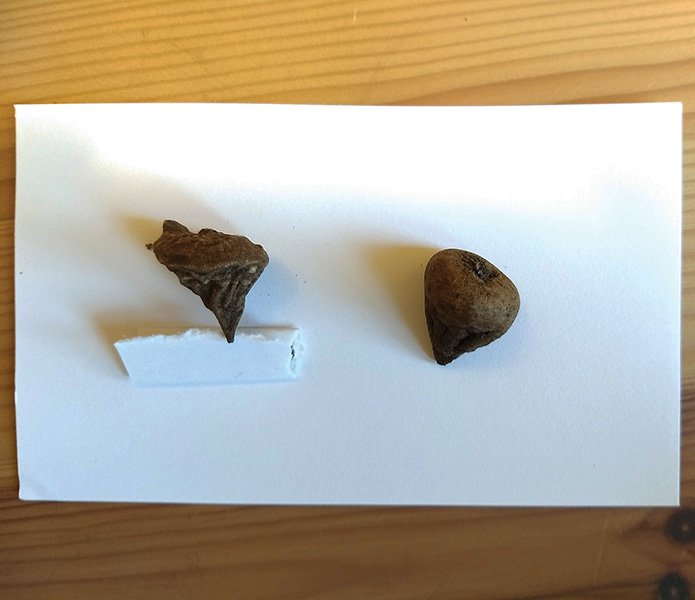 Anemone corms, before and after soaking.
Anemone corms, before and after soaking.
We grow our anemones and ranunculus in an unheated high tunnel. Caterpillar tunnels are also suitable. We even know growers who use single-bed low tunnels, a great option for beginning, urban, and micro-scale growers. Once established, anemones and ranunculus can take cold nights as long as the ground doesn’t freeze. Buds and blossoms must be protected from frost and freezing temperatures.
Ordering corms
When to order corms: Both anemones and ranunculus grow from a bulb-like structure called a corm, which is made up of modified plant stem tissue. As this article comes out in September, the time for planting anemones and ranunculus is rapidly approaching. But the first step in the process, ordering corms, should have been done last spring. If you don’t have any corms yet, you can reach out to your supplier and see what they still have on the shelf, or look on flower-farmer groups on social media to see if anyone has extra corms for sale.
Before you read any further, set calendar reminders for next spring so that you don’t forget to order during that busy time of year. Establish an account with one or more suppliers now to make the process go smoothly, and ask them when you should place your order for the best selection.
Where we buy our corms: We order our regular varieties of ranunculus, Butterfly Ranunculus, and all our anemones from the Ednie division of Ball Horticultural Company (ballhort.com/). We order Butterfly Ranunculus and Romance Ranunculus from Botanical Trading Company (botanicaltrading.com). Onings Holland Flowerbulbs (onings.com) offers popular Italian anemones and ranunculus. Corms come in different sizes. While larger corms cost more, they produce more and larger blooms. In our experience, it is always worth buying the largest corms available.
 Wild anemones blooming near the author’s aunt’s home in Israel. Photo courtesy of Uri Luzon.
Wild anemones blooming near the author’s aunt’s home in Israel. Photo courtesy of Uri Luzon.
Our favorite anemones: We love the Galilee series because they are reliable and have tall stems. We also grow the Rainbow and Marianne series for their unique colors, but they are a little more challenging. Rainbow is less robust for us than Galilee, and Marianne is prone to cracked stems, a common problem with anemones.
Our favorite ranunculus: For ranunculus, we grow the Amandine, La Belle, Half-Clone, and Clone series from Ball, as well as Butterfly Ranunculus. We particularly like growing a selection of the La Belle and other series due to their different flowering times. The La Belle blooms first but doesn’t tolerate heat well. The Amandine starts blooming later but blooms for much longer due to its greater heat tolerance.
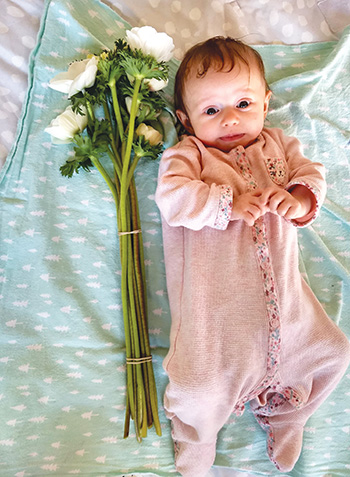 We like the Galilee series of anemones because of their long stems. Pictured here is Galilee White.
We like the Galilee series of anemones because of their long stems. Pictured here is Galilee White.
‘Champagne’ and ‘White Picotee’ are our favorite colors in the La Belle series because they are the earliest and are very beautiful. ‘Salmon’ is our favorite Amandine because of its very large flowers. ‘Half-Clone Marshmallow’ (formerly in the Amandine series) is exceptionally productive, with consistently large blooms and tall stems. Our favorite Butterfly Ranunculus are ‘Ariadne’ and ‘Hera,’ which both have double flowers.
This year we are also trialing two series we’ve never grown before, Tecolote and Romance. Tecolote (Ball) has a unique poppy-flowered form and unusual colors. Romance (Botanical Trading Company) is another introduction from Aya Engei, the same breeder who created Butterfly. Romance is reported to have larger flowers, taller stems, and be more productive, so we definitely want to give it a try.
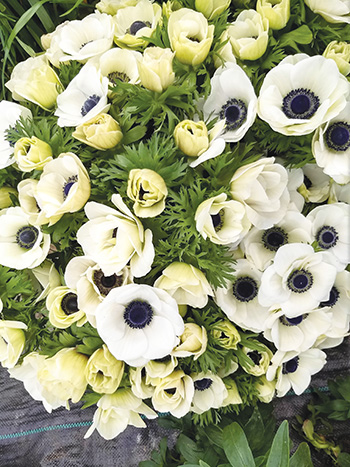 Galilee White anemone blooms.
Galilee White anemone blooms.
Are premium ranunculus worth it? Most Ranunculus corms are grown from seed, leading to variation of color and form. Cloned ranunculus is very uniform, making it desirable for events, and it comes in unique colors. Varieties such as the Italian ranunculus ‘Cloni Success Hanoi’ and ‘Butterfly Ariadne’ are very popular because of social media and may be requested by name. The Butterfly series is a unique spray form, and along with Romance, is exceptionally tall.
Ko Klaver, President and CEO of Botanical Trading Company, says these two series are popular with designers because their height allows them to be used in larger arrangements, unlike regular ranunculus which are more limited to bouquets. We can confirm that the Butterfly has spectacular height: We often get 36-inch stems which we have to cut down, because we can’t store or deliver a stem that long. We are hoping the Romance will be equally spectacular and fetch a premium price. Corms of these premium varieties can cost many times more than the regular ranunculus, so they are only worth it if your market will allow you to charge accordingly. We recommend you learn to grow less expensive varieties of ranunculus before buying these expensive corms.
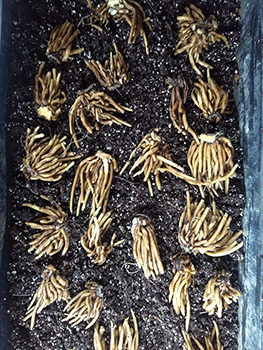 Soaked butterfly ranunculus corms are placed in a crate of damp medium for pre-sprouting.
Soaked butterfly ranunculus corms are placed in a crate of damp medium for pre-sprouting.
Soaking, sprouting, planting
When your corms arrive, they will be dehydrated, shriveled and small as they would be in the wild at the end of summer. You need to soak them to reactivate them. While corms are soaking, the water also needs to be oxygenated or they can die.
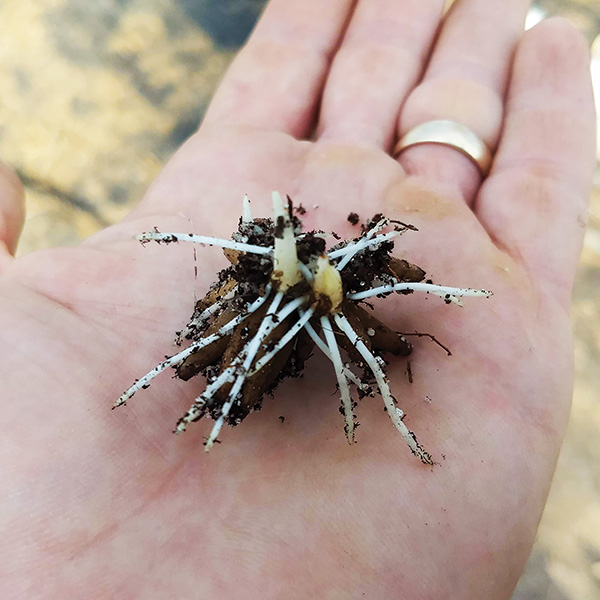 Pre-sprouted ranunculus.
Pre-sprouted ranunculus.
When to soak: Our corms arrive in September and we store them in our barn until we are ready to soak them. We soak corms between late October and early November before planting them in an unheated tunnel, which gives them time to get established before it gets really cold. These corms start blooming in late March and early April. Growers in the deep South may get January or February blooms with the same schedule. Growers in northern climates may need to plant their corms in the spring once the soil has thawed. Until then, corms can be stored in any warmish, dry location, such as a basement or closet.
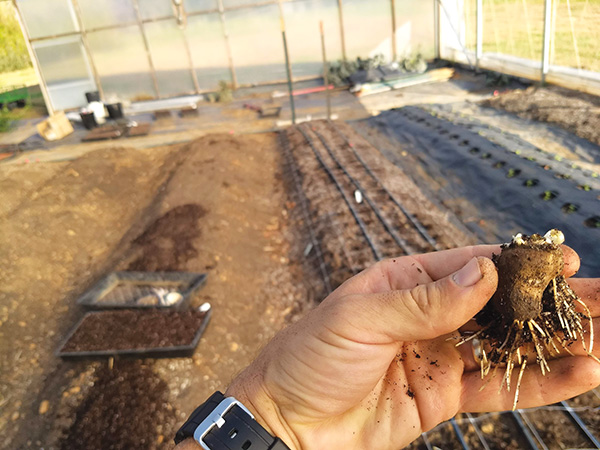 A pre-sprouted anemone corm ready for planting.
A pre-sprouted anemone corm ready for planting.
How to soak: We use an aquarium aerator with three stones to oxygenate our soak. We place each variety of corm in its own mesh bag with two labels for redundancy and place them loosely in a five-gallon bucket of cool water. The corms will plump up significantly, so make sure not to overpack them. We place the aerator stones under and around the corms. We soak ranunculus for a total of four hours and anemones from four to six hours, until they are firm and plump.
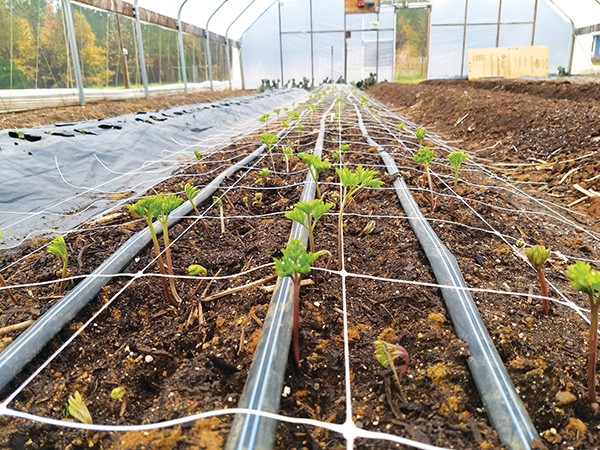 Anemones starting to sprout.
Anemones starting to sprout.
For the last hour of the soak we remove the aerating stones and add Actinovate and Root Shield at the recommended rates. Anemones and ranunculus are susceptible to rot and we think this helps minimize that. (This soaking method is adapted from Bare Mountain Farm. They have lots of great videos about growing anemones and ranunculus on their YouTube channel, youtube.com/baremtnfarm.)
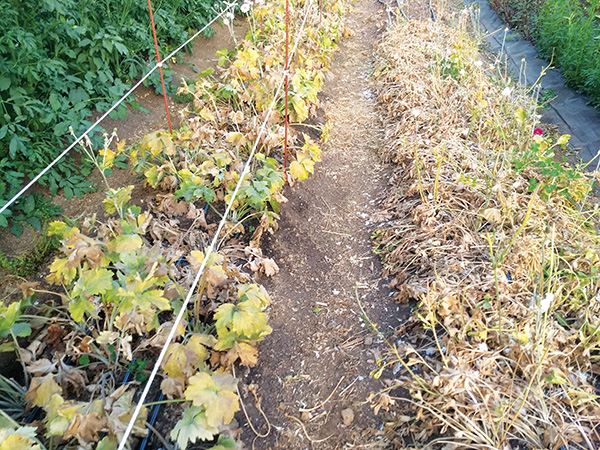 To pull corms, wait for the leaves to mostly die back, then use them to pull corms from the bed.
To pull corms, wait for the leaves to mostly die back, then use them to pull corms from the bed.
Pre-sprouting: At this point, although one could simply plant the soaked corms, most growers pre-sprout them to make sure that they are only transplanting viable corms into valuable high tunnel space. (Northern growers who have to wait until spring to plant may take it a step further and grow corms for several weeks in a fifty-cell tray in order to get a head start and transplant larger plugs.)
 We used a fork to loosen the bed before pulling out the large butterfly ranunculus corms.
We used a fork to loosen the bed before pulling out the large butterfly ranunculus corms.
To pre-sprout our corms, we use whatever light planting medium we have on hand. We’ve successfully used Pro-Mix as well as a 50-50 blend of peat moss and perlite. The medium should be damp but not wet. We fill a mesh-bottom 1020 flat with the medium, spread the corms in a single layer, discarding any that are mushy or moldy, and cover with more medium. We label each tray, cover it with a humidity dome, and place it in a 50°F to 60°F degree cooler. Once most of the corms have started developing roots or shoots, they are ready to transplant. This takes six to eight days for most varieties, but larger Butterfly Ranunculus can take up to two weeks and still may not show a lot of root development. During this time, we may mist the soil lightly if it starts to feel too dry.
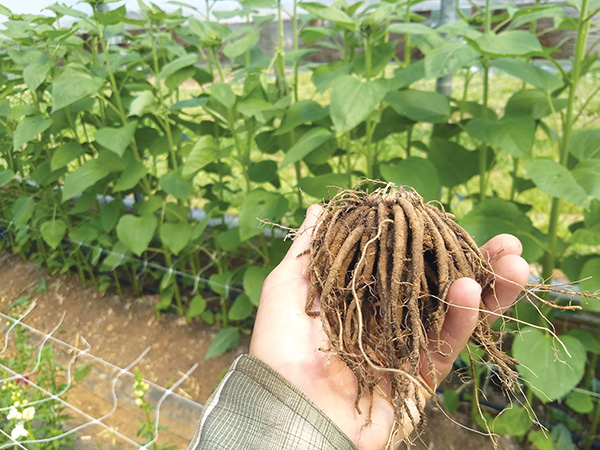 Saving corms means you can use larger, more productive corms. This butterfly ranunculus corm is massive.
Saving corms means you can use larger, more productive corms. This butterfly ranunculus corm is massive.
Planting: While the corms are sprouting, we prepare beds in our high tunnel. We amend soil based on results from an annual soil test. For anemones, we also add gypsum, which adds calcium and can help prevent stems from splitting. We used to fertilize with 75 lb/ac of nitrogen, but now we only use about 40 lb/ac. While the plants grew and bloomed well with the higher amount, we experienced split stems on our anemones and high levels of aphids and thrips. Lowering the initial feeding hasn’t had any effect on plant growth but has greatly reduced split stems and insect pressure.
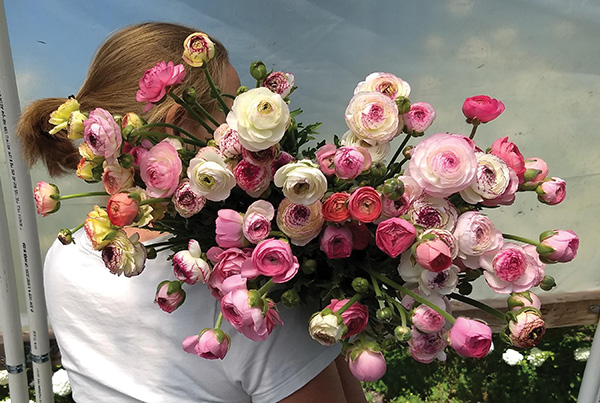 La Belle ranunculus are the first to bloom.
La Belle ranunculus are the first to bloom.
We plant anemones and regular ranunculus at four per square foot (one per hole of Hortonova netting) and Butterfly Ranunculus at one per square foot. The breeder recommends planting Romance Ranunculus at two per square foot. Both anemones and ranunculus get transplanted with the top of the corm about one inch deep. On ranunculus and anemones, the pointy end of the corm goes down. This can be counter-intuitive since the roots emerge from the top of the corm.
 This Galilee White anemone is at a perfect stage for harvest.
This Galilee White anemone is at a perfect stage for harvest.
For most of our crops we just lay drip tape on top of the bed. For anemones, however, we shallowly bury the lines. If we skip this step, we find the lines are very prone to being cut while harvesting anemones. After planting, we wet the entire bed surface really well by hand, and then water daily until plants emerge. After emergence, we cut way back on water, keeping the soil barely moist until active growth starts in the spring.
The key to keeping anemones and ranunculus blooming for as long as possible is to keep the soil cool. Warm soil is one of the key triggers of dormancy. We do not use landscape fabric for these crops because we don’t want anything that can trap heat. (Anemones send up shoots from all over the place and they can get trapped under a plastic mulch.) We do find that some sort of support is helpful for keeping the stems out of the paths. We have used both Hortonova netting and a simple rope. (See “Low Trellising Ideas” in the June/July 2021 issue of Growing for Market.) Both work well.
 La Belle White Picotee ranunculus.
La Belle White Picotee ranunculus.
If you are new to growing anemones and ranunculus, I hope this article gives you confidence about the soaking, pre-sprouting, and transplanting process. In part two of this series, I will go over how to care for your plants once they start growing and how to make the most of your beautiful flowers.
Jonathan and Megan Leiss grow half an acre of no-till flowers on their homestead, Spring Forth Farm, in Hurdle Mills, North Carolina. Megan and Jonathan’s course, The No-Till Micro-Scale Flower Farm is available from The Gardener’s Workshop: thegardenersworkshop.com.

